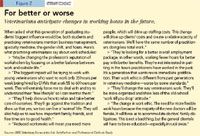Clocking in
Are new grads' expectations about quality of life and child rearing changing the veterinary workweek?
SIXTY-FOUR PERCENT OF RESPONdents to the 2005 Veterinary Economics Job Satisfaction and Professional Outlook Study say ideally they'd like to work fewer hours. And according to the 2005 Veterinary Economics Student Study, students also think hours are an issue. In fact, when asked, "What do you think will be this generation of graduating students' biggest impact on the veterinary profession?" students pointed to topics such as business management, specialty medicine, the gender shift, and hours. Consider these responses relating to work schedules:

> "Changing the mentality of what a good veterinarian is. A good veterinarian has knowledge and skill—but doesn't necessarily need to work 75 hours a week!"
> "The fact that most students are now women will change a lot of things. Most don't want to work 70 hours a week, and they all want to live comfortably. Many women want to work fewer hours, or part time, to care for their families."
> "Demanding better working conditions for veterinarians. Recent grads demand better benefits and more flexible, family-friendly hours."

Figure 1 Counting the hours
> "A lot of women means a lot of part-time workers."
> "Since it's mostly women right now, and most of us want to have lives and families outside of work, the profession may lose its high-stress, too-many-hours-a-week reputation."
> "Wanting to have time away from work, learning to not work 24/7."
(For practicing veterinarians' take on how the next generation will affect hours, see Figure 2.)
Good news: A 70- or 75-hour workweek may be more rare than these students think. According to the 2006 "State of the Veterinary Profession," a study conducted by DVM Newsmagazine, the average practitioner works 45.8 hours a week. That's just over the standard workweek—defined as 35 to 44 hours a week by the U.S. Department of Labor.
However, long hours aren't extinct. Twenty percent of respondents report working 56 or more hours per week. (For more see Figure 1.)

Figure 2 For better or worse
Interestingly, just over half of respondents to the DVM Newsmagazine survey report working about the same number of hours as in the past. Fifteen percent say they're working more, and 29 percent report working less.
Change underway
No surprise here, given the makeup of graduating classes, but practitioners are hiring more women. In fact, 77 percent of respondents to the 2006 Veterinary Economics Industry Issues Study indicate that they employed more female practitioners in the last five years. And 64 percent believe the veterinary profession presents special challenges for women. A respondent sums up one of the common challenges cited: "When returning from maternity leave, many women are looking for part-time hours rather than full-time hours."
More good news: Practices seem to be providing these opportunities. Sixty-five percent of those that employed more females in the last five years are offering more part-time or varying hours for doctors and staff members, according to the study. (For more on gender issues see "Is Gender Still an Issue?").